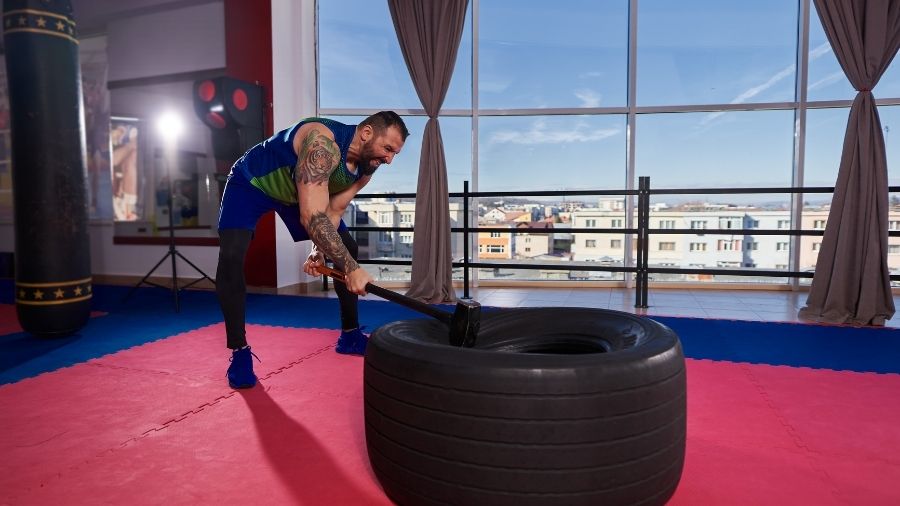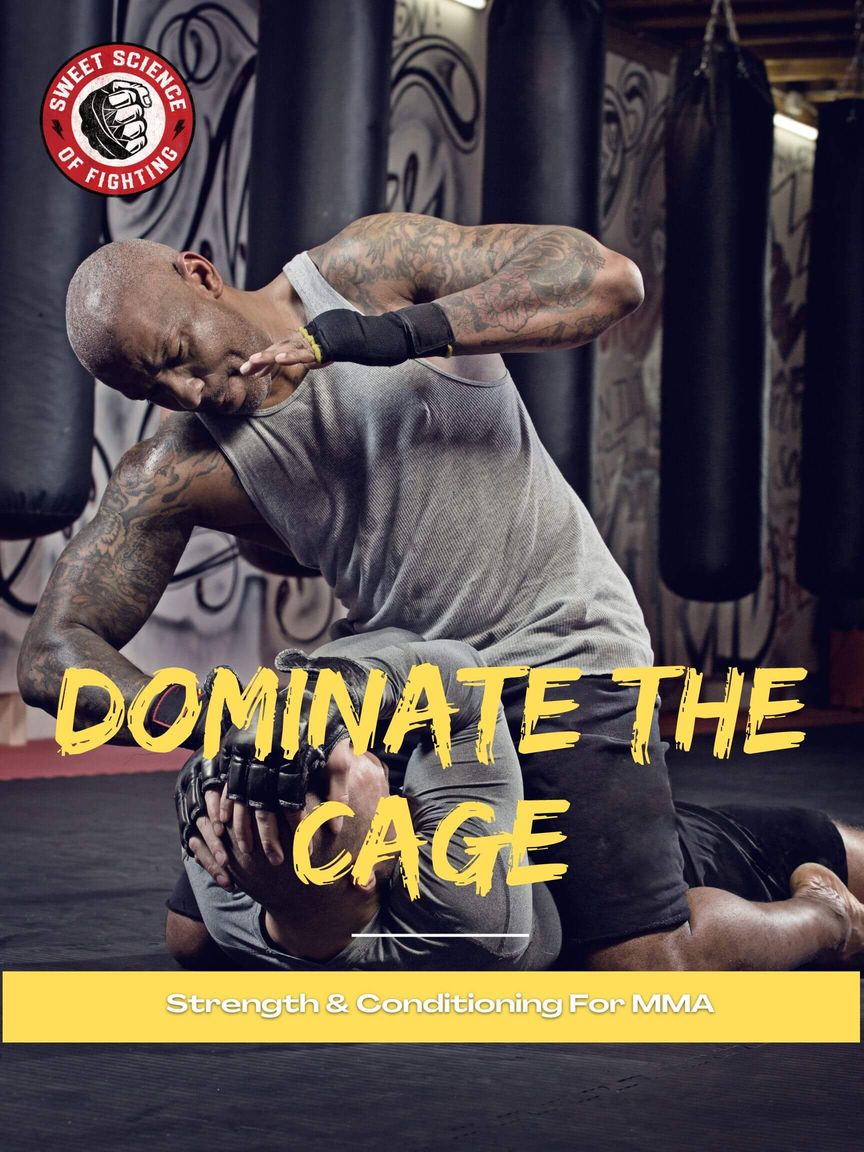Many MMA fighters get circuit training wrong. Endless battle ropes, burpees, and Olympic lifts are not how a circuit for MMA should be structured.
Circuit training for MMA is a great way to target the aerobic energy system through a selection of specific MMA exercises done in a circuit fashion. Meaning performing multiple techniques with little to no rest.
So, what makes circuit training good for MMA and what should circuit training for MMA look like?
Is Circuit Training Good For MMA?

Circuit training is a great training modality for MMA as it can be manipulated to fit the outcome and adaptations you want. Not just by how long or hard you do your circuit, but also by the exercises you select.
When we are performing circuits for aerobic or anaerobic adaptations, it’s more than just adaptations to the heart and lungs. Sure, we want to be able to improve our ability to deliver more oxygen to the working muscles and make our heart stronger.
But that doesn’t mean anything if we haven’t improved the ability of our muscles to use this increase in oxygen or be able to buffer the nasty by-products that build up in your muscles from intense exercise. This is known as peripheral adaptations or outside and away from the heart and lungs.
That is where exercise selection plays a prominent role in circuit training for MMA. The exercises used should rarely be similar to the local boot camp class at the commercial gym down the road. Sure, bodyweight exercises can have their place. But as an MMA fighter, using MMA techniques should be your number one priority.
This is because aerobic development is dependent on the muscles being worked and training should stimulate the muscles in the same way as the competition. Meaning lung-busting circuits of kettlebell snatches and battle ropes isn't going to transfer to the cage to the same extent as circuits of grappling drills, fence work, and shadowboxing.

How to Dominate Every Fight with Raw, Explosive Power No One Can Match
Discover the underground blueprint that has quietly turned MMA hopefuls into legends, using nothing but sheer, brute force and bulletproof conditioning techniques.
When deciding on sets, reps, time, and intensity of the circuit, it all comes down to the adaptations you want to target. There is an inverse relationship between time or volume and intensity. Meaning the longer your circuit intervals are, the lower the intensity will be and vice versa.
This refers to the maximum intensity you can maintain for the given time. That doesn’t mean you will be giving maximum effort for every interval. Aerobic adaptations will generally be targeted with lower intensity efforts and anaerobic lactic and a-lactic adaptations will generally be targeted with higher intensity efforts.
But there is more to circuit training than just energy system conditioning. There is also the aspect of using low-intensity circuits to prepare the body for high-intensity outputs. I’ve got examples of all of these below.
5 Wickedly Effective Circuits For MMA

Here are 6 wickedly effective MMA circuits to enhance your conditioning for MMA. Be aware that these circuits don’t touch on the high-intensity anaerobic side of conditioning. Mainly because you don’t train these qualities with circuits, rather in a high-intensity interval training (HIIT) format.
Extensive Jump & Plyometric Circuits For MMA Work Capacity
This is what I deem phase one of a training plan when it comes to developing power for MMA. You don’t want to start performing depth jumps and other high-intensity plyometrics and jumps when your body is not prepared for it.
This just increases your risk of injury and blunts the potential adaptation you’ll get from the exercise compared to when you build your way to using them. Think of very high-intensity jumps and plyometrics as the ace up your sleeve. Once you’ve played it, you don’t have it anymore.
So, here is a couple of extensive jumps and plyometric circuits you can use to prepare yourself for future high-intensity activity.
Bilateral Jump/Plyo Circuit
A1) Jump Squat x 10
A2) Extensive Box Jump x 10-15
A3) Lateral Squat Jump x 10
A4) Pogo x 20
A5) Sumo Squat Jump x 10
A6) Rolling Hop x 15-20
Perform 1-4 circuits with 10 seconds rest between exercises and 1-2 minutes between circuits.
Unilateral Jump/Plyo Circuit
A1) Split Squat Jump x 10
A2) Single Leg Pogo x 15
A3) Lateral Skater Jump x 10
A4) Single Leg Pogo Forward x 15
A5) Tuck Jump x 10
A6) Single Leg Pogo Backward x 15
Perform 1-4 circuits with 10 seconds rest between exercises and 1-2 minutes between circuits.
Extensive Medicine Ball Circuit For MMA
While jumps and plyometrics generally focus on the lower body, MMA is a full-body sport. So, we can't neglect the upper body when it comes to preparation for high-intensity activity. Medicine ball circuits are awesome and make a great conditioning modality. Here’s an example:
A1) Chest Pass x 20
A2) Rotational Pass x 10/side
A3) Scoop Toss x 10
A4) Rotational Slam x 10/side
A5) Forward Scoop Toss x 10
A6) Overhead Pass x 20
Perform 1-4 circuits with 10 seconds rest between exercises and 1-2 minutes between circuits.
MMA Aerobic Endurance Circuit
Long duration, steady-state cardio is going to build your gas tank for MMA. Doing it in a circuit format instead of traditional running and cycling is the best way to have it transfer to your MMA performance.
Because you have so many skills to cover within a training week, it’s difficult to find the time to address everything. Therefore, use your conditioning time to practice and hone skills and techniques while getting yourself fighting fit.
Here is a solo aerobic endurance circuit example and a partner aerobic endurance circuit example:
Solo MMA Aerobic Endurance Circuit
Shadowboxing x 10 min
Shadow wrestling x 10 min
Bag work x 5 min
BJJ solo drills x 10 min
Combination solo drills x 15 min
Partner MMA Aerobic Endurance Circuit
Wrestling shots x 5 min
Flow sparring x 5 min
BJJ drills x 10 min
Flow clinch x 5 min
Fence drills x 5 min
Perform in a 1 to 1 fashion so are continuously going back and forth.
MMA Aerobic Interval Circuit
2 x (5 x 3 min work/90-sec rest) with 3-5 min rest between series. Work interval performed under the anaerobic threshold (which generally sits between 165-175 BPM).
Each 3 min work interval can involve various MMA drills like the ones mentioned in the aerobic endurance circuits:
Shadow wrestling
Shadowboxing
Pad and bag work
Grappling drills
Solo MMA drills
MMA Strongman Circuit For Mixed Energy System Development
I'm a big fan of Strongman-style exercises. The Dominate The Cage MMA Strength Program has them sprinkled in. Strongman training for MMA has many benefits such as developing “farm boy” strength that you don’t get from traditional barbell training.
This transfers very well to grappling situations developing strength in awkward positions making them perfect exercises for developing strength for MMA. Further, Strongman exercises have a huge cardiovascular and strength demand. For example, pushing or pulling a car for 1 minute has similar cardiovascular demands to a 17-minute weight training circuit [1].
Here is how you could use a Strongman circuit for MMA:
A1) Reverse Sled Drag x 40-50 m
A2) Sandbag Bearhug Carry x 40-50 m
A3) Prowler Push x 40-50 m
Rest 2-3 minutes and repeat for 1-4 circuits.
Summary
Circuit training for MMA is a neat training tool that you can use to target different adaptations by manipulating the exercise selection as well as the volume and intensity of the circuit. Specific MMA exercises are much better to use than traditional cardio or strength training exercises as they transfer better to MMA.
Biggest, Baddest Gas Tank In Just 8 Weeks
Dominate The Cage is specifically designed to develop elite level MMA cardio based on your easy to implement test results


References
1. Woulfe, C., Harris, N., Keogh, J., & Wood, M. (2014). The physiology of strongman training. Strength & Conditioning Journal, 36(6), 84-95.

